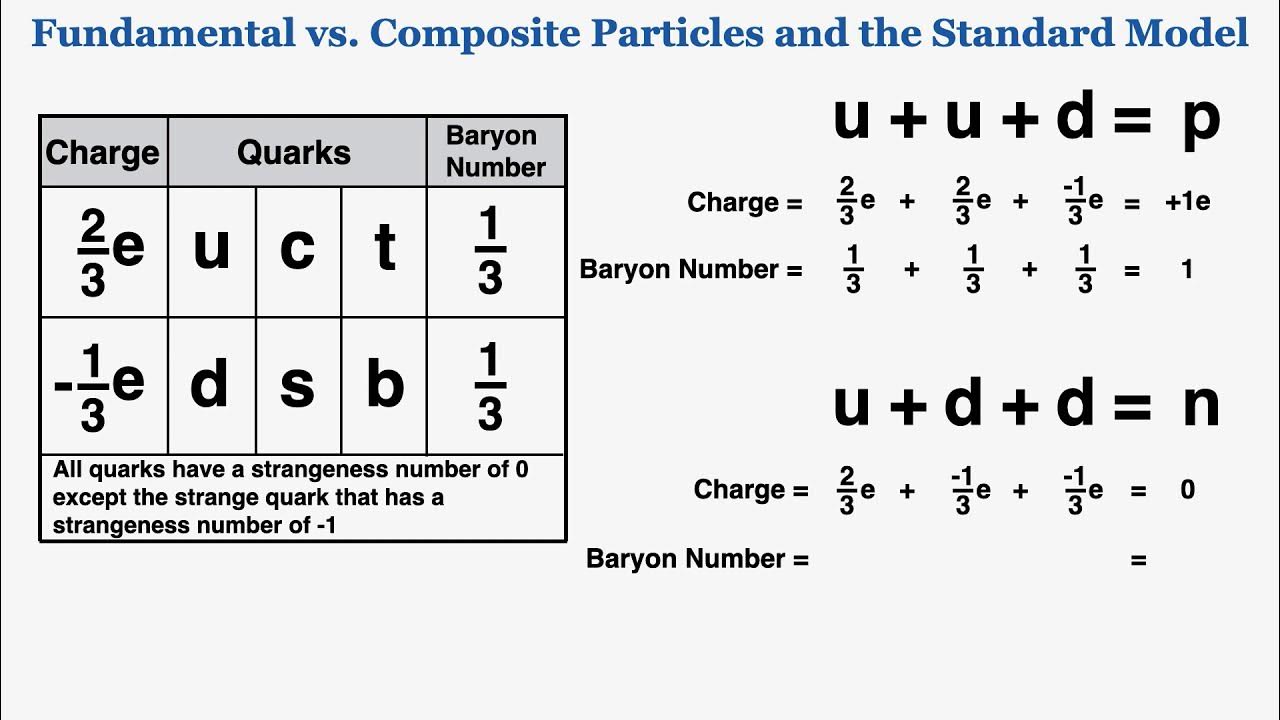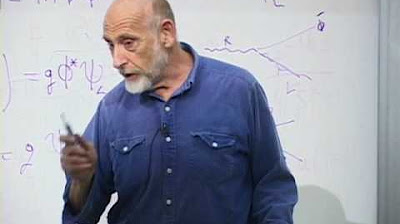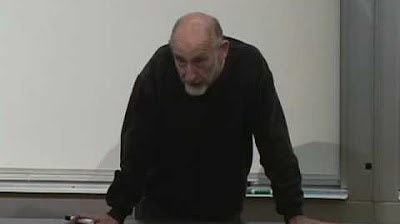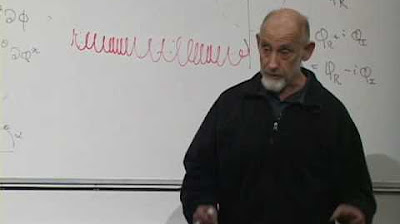The Standard Model - Particle Physics Reactions Part 1/3 (High School Physics)
TLDRThe video script introduces the standard model of particle physics, highlighting 18 elementary particles composed of six quarks and six leptons, collectively known as fermions that constitute all matter. It also discusses the bosons, including the photon, gluon, W and Z bosons, and the hypothetical graviton, as well as the unique Higgs boson, which imparts mass to other particles. The script further explains the composition of atoms and the existence of antimatter counterparts, as well as mesons, a subfamily of hadrons formed from quark-antiquark pairs.
Takeaways
- 🌟 The Standard Model of particle physics consists of 18 elementary particles, grouped into fermions and bosons.
- 🥼 Fermions, which make up matter, are further divided into six quarks and six leptons.
- 👔 The six quarks are up, down, charm, strange, top, and bottom, forming the building blocks of protons and neutrons.
- 🔋 Leptons include electrons, muons, and taus, each associated with its own type of neutrino.
- 💫 Bosons are force-mediating particles, including photons, gluons, W and Z bosons, and the hypothetical graviton.
- 🌐 The Higgs boson is a special type of boson that interacts with other particles to give them mass.
- 🔬 The top and bottom quarks interact significantly with the Higgs boson, which is why they have a large mass.
- 🚫 Photons and gluons mediate electromagnetic and strong forces, respectively, while W and Z bosons mediate the weak force.
- 🌌 The concept of the graviton is still uncertain as it conflicts with the principles of general relativity and has not been detected.
- 🌀 Quarks and leptons have antimatter counterparts, such as the anti-up quark and the anti-electron neutrino.
- 🔄 Mesons, a subfamily of hadrons, are formed by combining a quark with an antiquark, such as pions and kaons.
Q & A
What is the Standard Model of particle physics composed of?
-The Standard Model of particle physics is composed of 18 elementary particles, which include six quarks, six leptons, and bosons.
What are the six types of quarks?
-The six types of quarks are up, down, charm, strange, top, and bottom.
What are the three types of leptons mentioned in the script?
-The three types of leptons are the electron, the muon, and the tau.
What is the role of the Higgs boson in the Standard Model?
-The Higgs boson interacts with other particles, providing them with mass. It interacts significantly with particles like the top and bottom quarks, which is why they have a large mass, but it does not interact with photons and gluons, hence they have no mass.
How does the concept of the graviton fit into the Standard Model?
-The graviton is hypothesized to mediate the gravitational force. However, its existence is currently unconfirmed and it presents a theoretical conflict between Einstein's general relativity and quantum mechanics.
What is the relationship between quarks and the mass of an atom?
-Quarks, specifically up, down, charm, strange, top, and bottom, make up 99.8% of the mass of an atom, which is contained in the nucleus. The nucleus itself is made up of protons and neutrons, which are combinations of quarks.
What are antimatter counterparts in the context of quarks and leptons?
-Antimatter counterparts are particles that have the same properties as their matter counterparts but with opposite charges and other particle properties. For example, the anti-up quark is the counterpart of the up quark, and the anti-electronic neutrino is the counterpart of the electronic neutrino.
What is a meson and how is it formed?
-A meson is a subfamily of hadrons that are formed by combining a quark with an antiquark. For instance, a pion is formed by combining an up quark with a down antiquark.
What are the different families of bosons?
-The different families of bosons include the photon (which mediates electromagnetic force), gluon (which mediates the strong force), W and Z bosons (which mediate the weak force), and the hypothetical graviton (which would mediate the gravitational force).
How do fermions contribute to the matter around us?
-Fermions, which include quarks and leptons, are the building blocks of all matter. They make up atoms, which in turn make up everything around us in the universe.
What is the significance of the Higgs boson's interaction with the W and Z bosons?
-The interaction of the Higgs boson with the W and Z bosons is significant because it provides these bosons with mass. This is a crucial aspect of the electroweak symmetry breaking mechanism, which is a fundamental part of the Standard Model.
Outlines
🌟 Fundamental Particles and the Standard Model
This paragraph introduces the standard model of particle physics, which is composed of 18 elementary particles categorized into six quarks, six leptons, and bosons. Quarks and leptons, known as fermions, constitute all matter in the universe. The six quarks are up, down, charm, strange, top, and bottom. The three types of leptons are electrons, muons, and taus, each accompanied by its own neutrino. Bosons are force-mediating particles, including photons for electromagnetism, gluons for the strong force, and W and Z bosons for the weak force. The existence of the graviton, which would mediate gravity, is uncertain due to conflicts with general relativity and quantum mechanics, and it has not been detected. The Higgs boson, a unique boson, provides mass to other particles through interaction, with the exception of the photon and gluon, which remain massless.
🧬 Quark Composition and Antimatter
This paragraph delves into the composition of atoms and the role of quarks within them. It explains that 99.8% of an atom's mass comes from the nucleus, which is made up of protons and neutrons. Both protons and neutrons are composed of quarks, with protons being made of two up quarks and one down quark, and neutrons having one up and two down quarks. The paragraph also discusses the concept of antimatter, where every quark has a corresponding antiparticle, denoted with a bar on top. This includes anti-up, anti-down, anti-charm, anti-strange, anti-top, and anti-bottom quarks. Additionally, the paragraph introduces mesons, a subfamily of hadrons formed by combining a quark and an antiquark, with examples like pions and kaons, which contain a strange quark.
Mindmap
Keywords
💡Standard Model
💡Elementary Particles
💡Fermions
💡Quarks
💡Leptons
💡Bosons
💡Higgs Boson
💡Antimatter
💡Hadrons
💡Mesons
💡Graviton
Highlights
The standard model of particle physics consists of 18 elementary particles.
There are six quarks and six leptons, which are grouped into a family called fermions.
Fermions are particles of matter and constitute all the matter in the universe.
The six quarks are up, down, charm, strange, top, and bottom.
The six leptons include three types of electrons and their associated neutrinos.
Bosons are another family of particles that mediate forces.
The photon mediates the electromagnetic force, while the gluon mediates the strong force.
The weak force is mediated by the W+, W-, and Z bosons.
The concept of the graviton, which would mediate the gravitational force, is unconfirmed due to conflicts with general relativity and quantum mechanics.
The Higgs boson is a special type of boson that provides mass to other particles through interaction.
The Higgs boson interacts significantly with top and bottom quarks, which is why they have a high mass.
The Higgs boson does not interact with photons or gluons, hence their mass is zero.
Matter is made of atoms, which are composed of a nucleus and electrons.
The nucleus of an atom is made of protons and neutrons, which in turn are made of quarks.
99.8 percent of an atom's mass is in the nucleus, primarily made up of quarks.
Quarks combine to form hadrons, such as baryons and mesons.
Baryons include protons and neutrons, while mesons are formed from a quark and an antiquark.
Fermions have antimatter counterparts, such as the anti-up quark and the anti-electronic neutrino.
Kaons are mesons containing a strange quark and either an up or down quark.
The standard model is a fundamental framework for understanding the basic building blocks of the universe.
Transcripts
Browse More Related Video

Fundamental vs. Composite Particles and the Standard Model - IB Physics

Lecture 9 | New Revolutions in Particle Physics: Standard Model

Lecture 4 | New Revolutions in Particle Physics: Standard Model

Lecture 7 | New Revolutions in Particle Physics: Standard Model

Fundamental Particles

The Map of Particle Physics | The Standard Model Explained
5.0 / 5 (0 votes)
Thanks for rating: